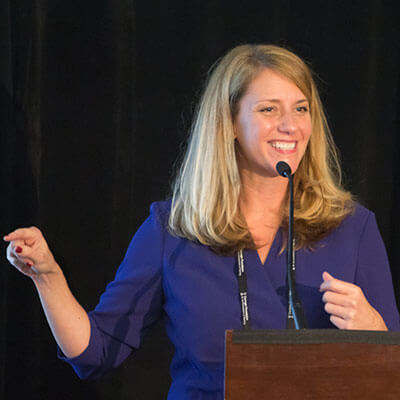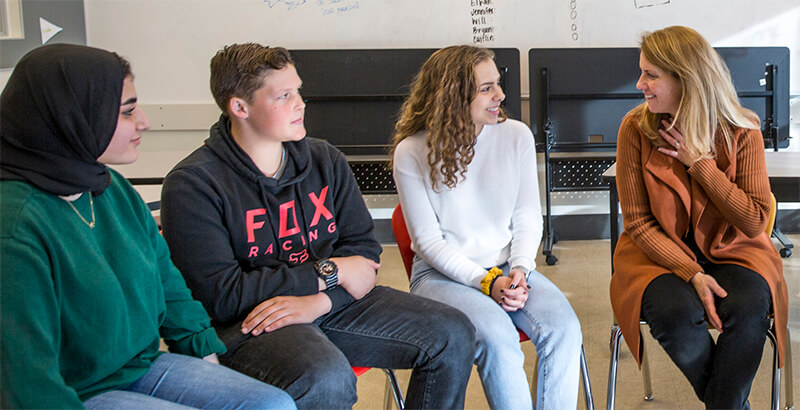“Let’s Get Real”: Diane Tavenner on Unlocking Post-High School Pathways

Explore this illuminating Q&A with Carnegie Foundation Board Chair Diane Tavenner as she discusses her journey from the K12 sector to launching her latest venture. Discover Diane’s framework for categorizing post-high school learning pathways and read about her strong belief in empowering young people with transparent, actionable information about post-high school options.
Diane brings a vast range of expertise to her current position as co-founder and CEO of Futre.me, an emergent online platform that enables young people to explore, compare, plan, and act on a fulfilling future post-high school. Diane is the founder of Summit Public Schools where she led the organization for two decades. She is also the co-host of the The74’s Class Disrupted podcast and the author of Prepared Parents.
Tell us about your decision to launch Futre.me after your leadership tenure at Summit Public Schools. Why is this work so important, particularly now?
For the last 20 years, I was with Summit Public Schools, and before then I worked in a variety of traditional schools throughout my career – and especially while at Summit – I witnessed significant societal changes. Initially, K12 educators, like myself, focused our efforts on supporting students, particularly those from low-income and underrepresented communities, to be on track for the clear post-high school pathway: four-year college. However, over the years, our sector has learned that simply getting into college isn’t enough to secure a self-sustaining, fulfilling future. High student drop-out rates, increased job market competition, and sustained difficulty securing jobs that have a good ROI on a postsecondary degree have made it clear we missed the mark despite our best intentions. Simultaneously, higher education has remained unchanged while costs have skyrocketed, creating immense student debt. Simply put, I could no longer continue sending students into this system post-high school.
This is why I have chosen to embark on a new journey and launch Futre.me. While large-scale transformation is critical for the future, student-facing tools and resources are essential for young people to navigate their options post-high school. This orientation frames the vision for Futre.me as we are building a student-facing, usable platform that doesn’t require adult guidance or intervention for young people to discover, explore, plan, compare, and act on a future post-high school that leads them to the life that they want to lead.
What is one key feature of Futre.me that you think is missing in the field?
To be clear, we are in the early days of Futre.me and I am on a deep learning journey, approaching information with childlike wonder and curiosity to understand what must be done to move the needle for young people in our education system. That being said, the number one thing we’re aiming for at Futre.me is to be trusted by young people. There are a lot of good reasons that this generation of young people does not trust institutions. For us to be trustworthy, we must share all available data and not sugarcoat information so they can make informed decisions about their futures. A great deal of information about post-high school options is opaque, resulting in young people having few tools to make important decisions about their careers.
Let’s get real. The system is engineered to not enable agency and self-directedness and that’s precisely what we’re seeking to overturn with Futre.me. I hope that by providing accurate and accessible information to young people, pressure will be applied for necessary systemic change. Ultimately, we need to be real about the options high school students have post-graduation, and then we need to change the system.
How do you define pathways?

Cindy Wang, my co-founder at Futre.me, and I have dug into this definition. While the term ‘pathway’ is so incredibly ubiquitous in our sector, we currently define pathways as the learning experience (or experiences) that a young person has post-high school that launches them into a career. At Futre.me, we have identified 863 current careers in America which require a post-high school pathway of learning. From our research, we believe that almost all careers that are worth having financially require post-high school learning to land.
One caveat to this definition is the potential of high school career and technical education programs (CTE). While the number of CTE programs across the country is prolific, I know of only one program in a South Carolina high school that successfully graduated five students who were employed by the local fire department the day after graduation, thanks to their high school fire science CTE program. This example highlights that there is immense opportunity to invest in high school CTE programs that ensure participants are employable immediately after graduation. Further, an enormous benefit of employer-ready high school CTE programs is that students are not responsible for financing their learning, unlike college and other post-high school pathways.
In a recent conversation with our colleague Diego Arambula, you mentioned there only being a handful of “real” pathways. What are these pathways?
From our research at Futre.me, we believe the following post-high school pathways exist:
- Four-year colleges or universities that grant bachelor’s degrees;
- Community colleges, potentially split into:
- Transfer programs to four-year colleges and universities
- Career-learning program courses leading to certifications or licenses;
- Apprenticeships that offer paid job experience while learning a trade or skill, primarily in the trade, advanced manufacturing and health services sectors;
- Vocational schools that provide targeted training often in healthcare or technical fields, leading to certifications or licenses;
- Military pathways, which combine service with educational opportunities, including:
- Active duty military
- Military reserves
- Reserve Officers’ Training Corps (ROTC)
Each pathway above is distinguished by its educational focus, cost implications, and the career outcomes it supports. Of course, there is overlap between various pathways. For example, students who pursue ROTC training are likely educated within a 4-year college or university. Similarly, some apprenticeship programs are situated within or partner with community colleges. While these pathways are nuanced, we think it is important to differentiate between them by using a user lens. Put differently, who is responsible for the payment of a learning pathway is a critical component for students when determining their options.
Which pathway(s) do you think are the most promising?
I think the biggest opportunity is in the apprenticeship world, specifically because it is attractive to everyone and there is almost no opposition. There is so much excitement for apprenticeships because they are such compelling pathways where young people are hired and paid a wage to work while simultaneously learning and gaining experience in a specific field.
Today, the challenge is that apprenticeships are largely not a real option for most young people. Not only are these pathways almost exclusively offered in select industries like the trade and technical industries, but also the availability of these programs is highly over-inflated. While there are roughly 27,000 registered programs with the federal government, we are struggling to confirm how many of these are functioning. In our random sampling so far, at least half are not accepting applicants. Consequently, very few 18-year-olds can compete for highly selective apprenticeship programs. An additional challenge is the lack of intermediaries to leverage existing funding and resources to systemize these programs.
What will it take to create more robust and accessible apprenticeship pathways for young people?
To date, community colleges have served as the main intermediaries for apprenticeship pathways. However, for many reasons, this has not worked very well to ensure apprenticeships are aligned with employers and are widely accessible. In reality, we’ve found that apprenticeships require a high level of dedication from passionate individuals who take it upon themselves to knit the whole system together. Simply put, this is not a well-functioning or accessible system that serves young people.
While there is a lot of bureaucracy, I believe we are in a moment of opportunity for real public and private investment in apprenticeship pathways. One answer is that there is space for strong, entrepreneurial, mission-driven not-for-profits to serve as intermediaries to systematize apprenticeship pathways. Secondly, community colleges must be called on to do more to support apprenticeship opportunities for their students.
Why don’t we see more models like this scale and spread? What do high schools need to do, and what do institutions of higher education (IHEs) need to do to support pathway initiatives?
During my K12 career, I was very aware that everyone dreams of school being deeply connected to and integrated into the business community. Oftentimes, though, this doesn’t happen despite the best intentions. This also seems true for higher education and the workforce. Currently, the vast majority of institutions of higher education do not take accountability for what most Americans want from their postsecondary education which is to secure a well-paying, purposeful job. The fact that many colleges and universities will not report their graduates’ earnings and options after school disempowers young people from making good consumer decisions after high school. Ultimately, higher education has very little incentive to change, so K12 must stop deferring to colleges and universities as the direct connection to employers since so many high school students go straight into the workforce upon graduation.
What do high schools and IHEs need to do in partnership to support pathway initiatives?
At the high school level, I am very supportive of enabling more high-quality CTE programs. From my perspective, this would look like more programs that allow a young person to start, if not complete, a pathway to a career before they leave high school. This would bring positive change in terms of more student engagement and hands-on, personalized learning opportunities. Importantly, the CTE framework does not fall victim to all the old traps of tracking, racism, and sexism if you have a truly personalized learning environment where every student is on a pathway.
At the higher education level, I would like to see two things. First, colleges and universities need to transparently track graduate (and non-graduate) outcomes, in terms of career opportunities, debt, and so on. Second, higher education could honestly map majors to careers, clearly identifying the skills, outcomes, and opportunities for students. While this is a revolutionary idea for higher education, it is in students’ best interests so they can make informed decisions about the institutions they attend, majors to study, and the career options available post-graduation.
The key to fostering collaboration between K-12 and higher education lies in adopting a user-centric approach. By viewing education from the perspective of the student—mapping out clear, seamless pathways from high school through higher education to careers—both sectors can better identify and address gaps and barriers. This shift in perspective would lead to more cohesive educational journeys that prepare students more effectively for the future.
June 25, 2024
At the end of a demanding and dynamic school year, we naturally want to celebrate the accomplishments of our students. My thoughts also turn to the hundreds of thousands of teachers and mentors – in classrooms, after-school programs, and internships, at work and volunteer opportunities, and on practice fields –…
July 25, 2024
At Carnegie, the heart of our work is to make education a much more powerful engine of economic opportunity for all. We are working to transform the American high school, partnering with the XQ Institute, pathfinding educators, school systems, and states and leading institutions across the nation.







